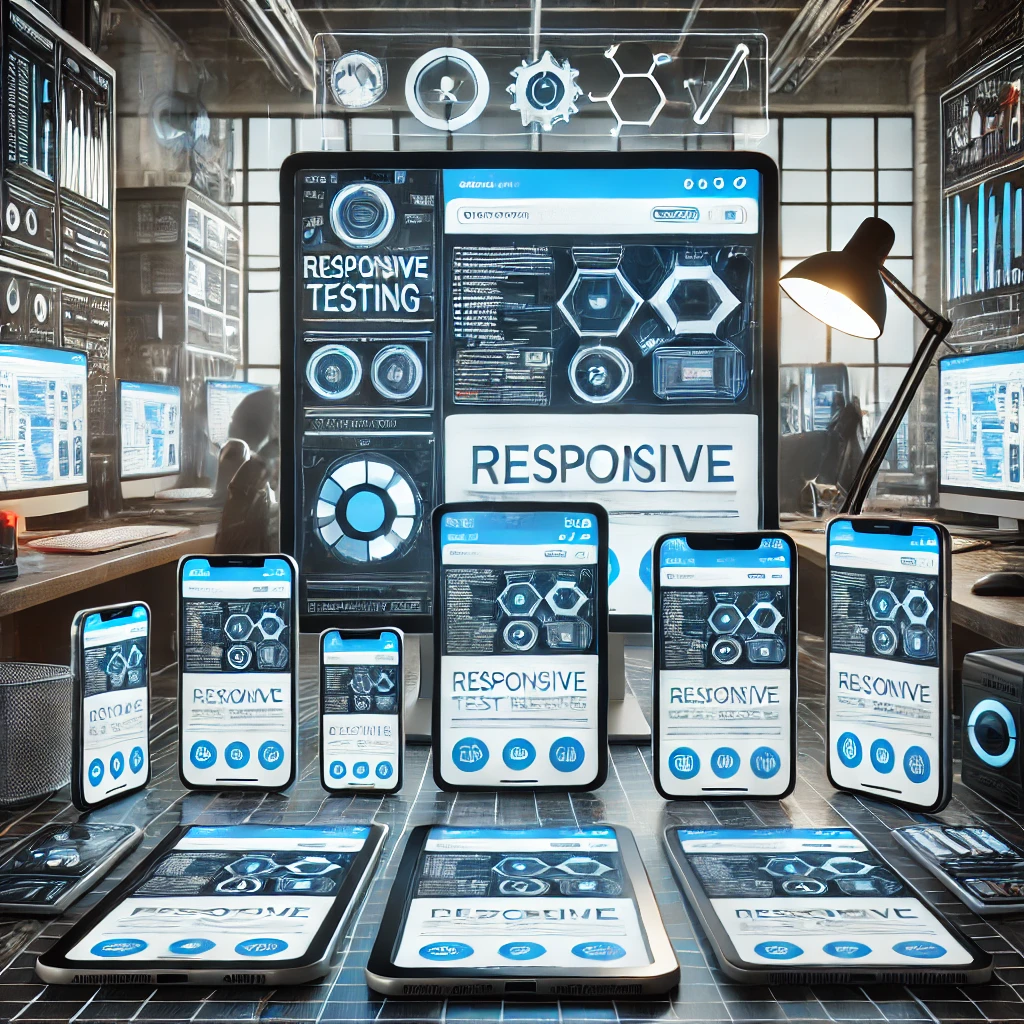Given that the use of mobile devices is rapidly rising the website must be navigated seamlessly across all devices. That is why, today, for almost every person, there is a mobile device; thus, it is crucial to create a user experience appropriate for the level of interaction that the business wants to provide.
However, without the proper testing tools and methodology, such as when the websites and applications are being targeted for an enormous number of screens, browsers and operating systems, this can be regarded as a daunting task. Mobile site testers play an indispensable role here, facilitating automated validation at scale through virtual devices and live device farms.
Understanding Mobile Site Testing Tools
When it comes to thoroughly validating the user experience of a website or application across countless mobile platforms, relying solely on manual testing methods quickly becomes an arduous and unsustainable process. This is where mobile site testing tools provide immense value, enabling automated validation of functionality and performance across a virtually limitless array of device and browser configurations remotely through desktop computers.
These specialized testing utilities emulate different mobile environments and browsers within the automated testing scripts, saving monumental time and effort compared to manually testing each permutation on real devices.
Some key capabilities that most mobile testing tools provide include mobile viewport emulation across resolutions from small phones to large tablets, geolocation controls to test region-specific features, simulator environments to test responsive design breakpoints, touch interaction simulation via swipes and taps, and integration with popular developer tools for debugging issues.
Further, many tools allow recording video of test sessions for easy review, offer live device farms to complement emulator capabilities and enable parallelization of test suites for rapid, full-scale validation. When leveraged strategically, such automated cross-platform testing solutions empower engineering teams to move faster and more confidently while assuring an optimal experience across all user devices.
The Importance of Using a Mobile Site Tester
Let us understand some key aspects of using a mobile site tester.
- Ensures cross-browser compatibility: Mobile site testers help test websites on various mobile devices using different browsers, such as Chrome, Safari, Firefox, etc., to ensure compatibility. This improves the user experience significantly.
- Delivers responsive designs: Responsive design is crucial for mobile experiences. Testers enable testing responsiveness across varied screen sizes easily to certify appropriate layout and viewport support.
- Validate performance: Performance is key for high mobile engagement and conversion. Testers help ensure optimum performance by testing load times, page speeds, app install sizes, and network conditions on multiple real devices.
- Simulates real scenarios: Features like geolocation manipulation and connection type/speed adjustments help mimic real-life situations and edge cases beyond static testing alone, revealing more issues.
- Leverages automation: Automated functional and integration test scripts facilitate swiftly and regularly testing diverse configurations in CI/CD pipelines to avoid regressions. Early bug detection aids in fixing.
- Scales quality assurance: Testing myriad mobiles manually is incredibly time-consuming. Cloud-based testers empower scaling tests across 1000s of actual smartphones/tablets remotely in parallel through device grids.
- Find UI/UX bugs: Simulated gestures and steps facilitate exposing user interface glitches like poorly placed buttons, non-responsive screens, etc., early to streamline the overall experience.
- Enhances collaboration and collaboration: Centralized dashboards and detailed reports from testers empower efficient collaboration between developers and testers for rapid troubleshooting and fixing.
Top Automation Testing Tools for Mobile Testing
Testing websites across a wide variety of mobile screens, browsers, and operating systems can present unique challenges. Below, we have listed some of the best available tools and methods for appropriate testing of the functional and overall user experience of your mobile website across different devices:
LambdaTest
LambdaTest is an AI-powered cross-browser testing platform that enables testers to run Selenium mobile testing across 3000+ browsers and operating systems. It provides users with access to various versions of Windows, macOS, iOS, and Android on native devices hosted in a secure cloud data center.
With LambdaTest, teams can run both manual and automated test scripts in parallel and fast-paced environments like continuous integration and delivery pipelines.
Some key features include an interactive web-based browser, video and screenshot recordings of test runs, integration with CI/CD tools, and automation frameworks like Selenium, Appium, etc. LambdaTest helps fully automate cross-browser compatibility testing with real devices without maintaining expensive on-premise infrastructures.
Appium
Appium is a freely available test automation tool that is widely utilized for carrying out tests on native and hybrid mobile applications built for both iOS and Android operating systems. It drives directly into the native iOS and Android APIs to interact with mobile applications. Using JSONWire Protocol, Appium communicates directly with a chosen driver to implement automated tests on a real or emulated device. Developers can write Appium tests using Java, Javascript (using NodeJS), Python, PHP, and C#/JavaScript with Selenium WebDriver.
Appium also provides a user-friendly UI inspector to automate any mobile application with visual, record-and-playback capabilities. Users can emulate certain gestures common in a device, including tapping, swiping, pinching or scrolling for an assessment of the app. As for application testing, it can be performed on actual mobile devices or with the help of emulators/simulators related to both iOS and Android.
Espresso
Espresso is the official UI testing framework for Android applications that allows developers to test activities, services, and content providers. It is focused on performing user-driven UI tests that simulate real user behavior on Android applications. Espresso tests run as part of your application process, simplifying testing and avoiding much complexity. It has a very low learning curve and is easy to integrate into existing projects. Test cases can be written in Java, Kotlin or any JVM-compatible language, and tests are more stable and less prone to flakiness than other testing frameworks. Espresso focuses on validating UI through synthetic gestures like clicks, swipes, drags, etc., which makes it a reliable Android UI testing framework.
Selendroid
Selendroid is an open-source Android WebDriver implementation that allows building native and hybrid mobile-web acceptance tests for Android applications. It expands on Selenium WebDriver’s capabilities to test Android-specific UI widgets and gestures. Selendroid removes incompatibilities between native Android APIs and web standards. Developers can write tests using Java, C#, and Selenium IDE to test Android apps locally or on LambdaTest.
Some key capabilities include testing Android-specific elements like Menu buttons, date pickers, Auto-complete text boxes, etc., using consistent Selenium API. Selendroid driver can be easily integrated with testing frameworks like TestNG, JUnit, etc. for building robust native and hybrid Android application test automation suites.
Robotium
Robotium is an Android testing framework that simplifies the writing of test cases for Android applications using the ActivityInstrumentationTestCase2 base class. It mimics user behavior by generating UI events and ensures reliable validation of Android applications. Robotium supports various functions like clicking buttons, entering text, selecting list/menu items, verifying textual elements, etc., to simulate user actions on applications.
It helps test Android applications’ activities, services, and content providers. Robotium tests can be written in Java using the Android JUnit testing framework, and suites can be executed on emulators or real devices. It has good documentation and active community support to help new testers create stable and maintainable test frameworks.
XCUI Test
The XCUI Testing framework from Apple helps automate UI tests by using simple and declarative syntax for the iOS platform. It allows controlling and observing Xcode projects, iOS simulators, and devices programmatically. XCUI Tests are written in Swift and can run standalone from Xcode or as part of a continuous integration and deployment pipeline.
Some key capabilities include tapping, swiping, entering text, dragging gestures, and asserting test expectations via visual or code checkpoints. XCUI resolves any elements on the screen uniquely using IDs, names, types, orientation, etc., making tests more readable and maintainable. Developers can perform fast operation validation snapshot comparisons using this framework on simulators and physical iOS devices.
Robot Framework
The Robot Framework is a versatile tool for the automation of testing and inspection of various applications, including mobile web, native, and hybrid on Android and iOS platforms. It can be used to write test cases/suites through a simple plain text syntax and is scalable owing to its plugin architecture. Robot Framework tests are easy to maintain and modify.
It incorporates the open-source SeleniumLibrary for testing mobile and desktop websites while using AppiumLibrary for testing mobile apps. Some advantages of Robot Framework include multi-language support (Python, Java, C#, etc.), cross-platform capability, collaborative development culture, and vast libraries for extending functionality. It is a reliable option for automating both web and mobile testing.
Katalon
Katalon is an all-in-one platform offering automation for web, mobile, and API testing. It supports test design, execution, and analysis for web applications, mobile apps, and REST/SOAP services. With Katalon, automated tests can be run across desktop and mobile browsers through its integrated web driver or device cloud. It also features a powerful record-and-playback tool, along with scripting capabilities using the Groovy language.
Some key capabilities include mobile cross-browser testing via LambdaTest integrations, video testing, cloud or on-premise execution support, test case management, and detailed report generation. For mobile applications, Katalon supports testing on both emulators and real devices using the Appium library. Overall, it is a widely used end-to-end testing solution that covers different testing needs.
Kobiton
Kobiton is a popular cloud-based mobile and web infrastructure solution focused on real device testing. It allows executing tests in parallel on Kobiton’s large device farm containing a wide range of real mobile devices across different global locations. Some distinct features of Kobiton include live remote access to physical iOS and Android devices, real-time test results and video capture, automated testing using Appium, selenium mobile testing and frameworks like Xamarin UITest, support for on-device testing scenarios beyond web browsers, test sharing platform, and direct integrations with CI/CD tools.
Kobiton’s device streaming functionality uses real-world performance metrics through real devices to help deliver reliable results compared to emulators/simulators. It is widely adopted for its ease of cross-device testing and wide device coverage.
TestRigor
TestRIGOR is a cloud-based automation testing platform for web, mobile web, and native/hybrid mobile applications. It enables testers to author tests visually with their record-and-playback capabilities or via coding languages supported by Selenium. testRIGOR’s AI-driven test recommendations and feedback loops help improve test suites. Mobile testing options include real device and emulator/simulator grid, Appium support for native/hybrid apps on Android and iOS, and frameworks like XCTest and Espresso.
Key features include live remote access to 2000+ physical devices, a self-healing grid, video recording, and on-device test debugging and reporting. testRIGOR offers scalable testing infrastructure without upfront infrastructure costs, making it a cost-effective automated testing solution for all kinds of enterprises.
Conclusion
Testing websites and applications across a wide array of mobile screens, browsers, and operating systems requires a comprehensive, cross-platform approach. Utilizing a combination of automated testing scripts run via tools like Selenium and periodic manual validation sessions on actual devices helps ensure that all functionality and subjective experience factors are thoroughly validated.
Cloud-based cross-emulator testing services offer a very convenient and scalable option. At the same time, direct access to real smartphone and tablet devices remains essential for validating nuanced native experiences and performance attributes. A thoughtful mix of these methodologies will set organizations up for success by guaranteeing their digital products render flawlessly regardless of the mobile environment.










